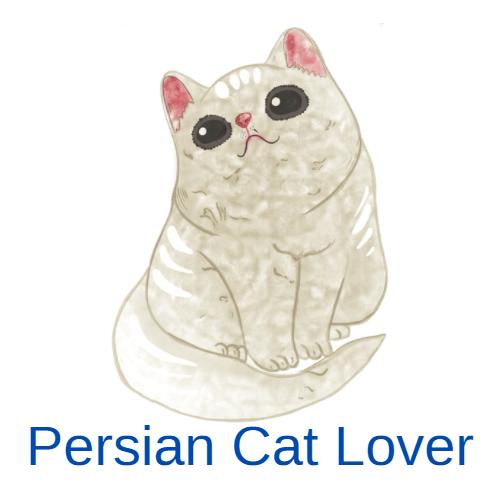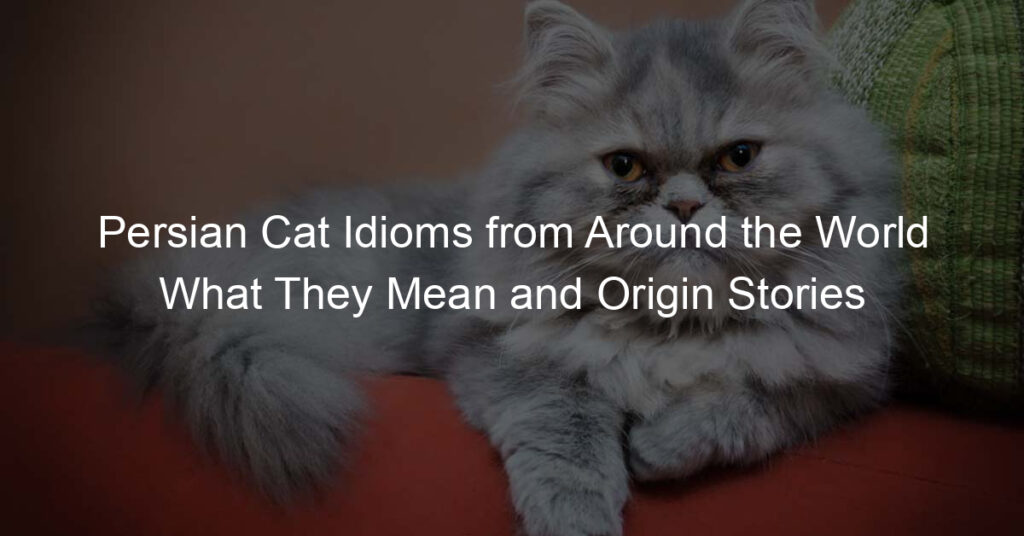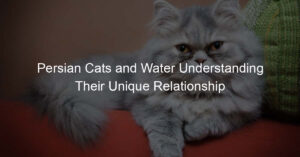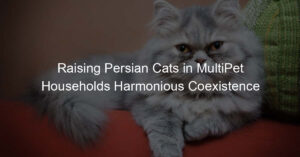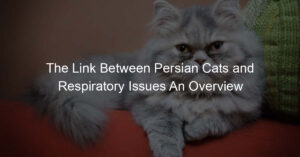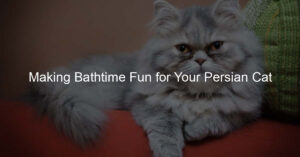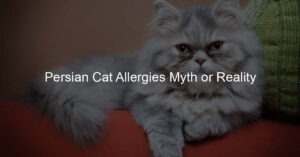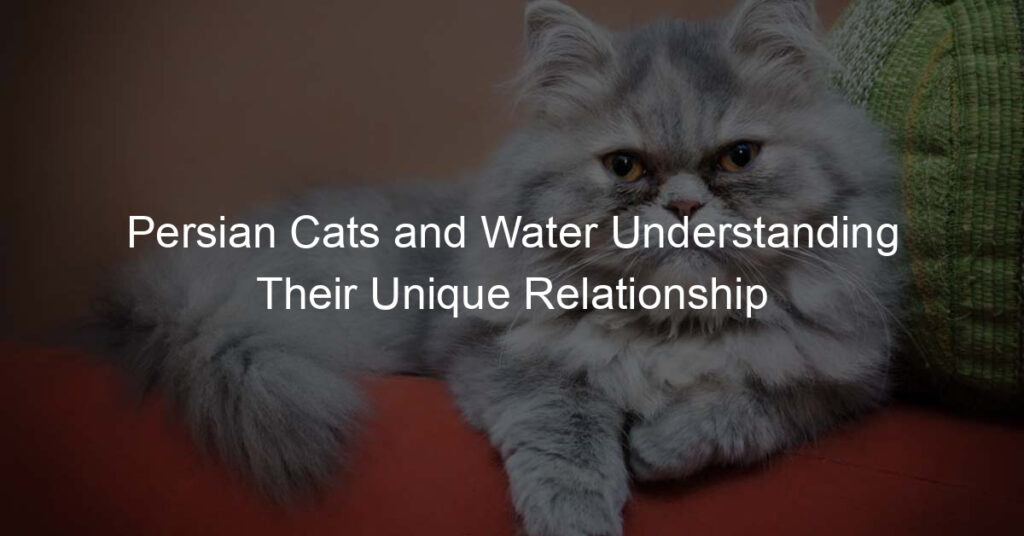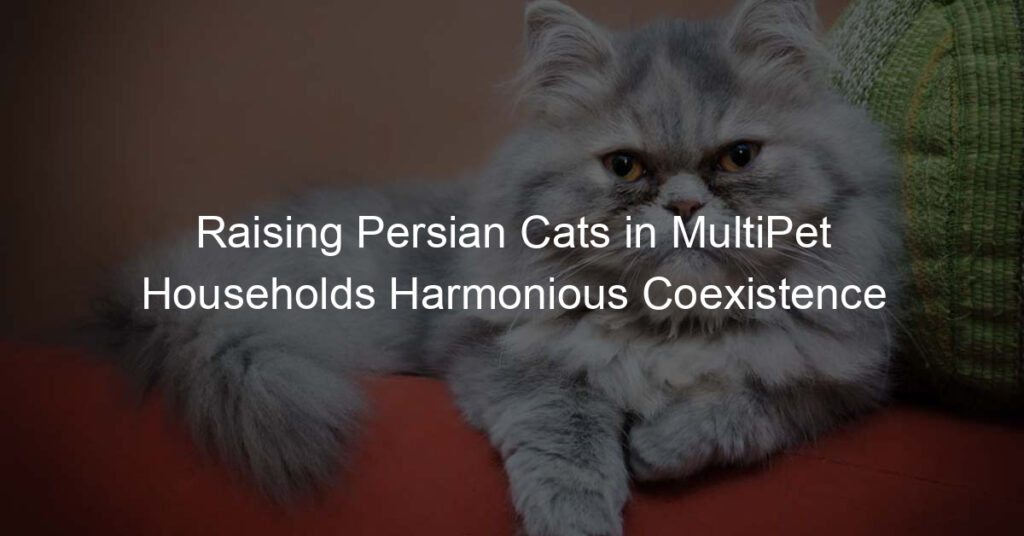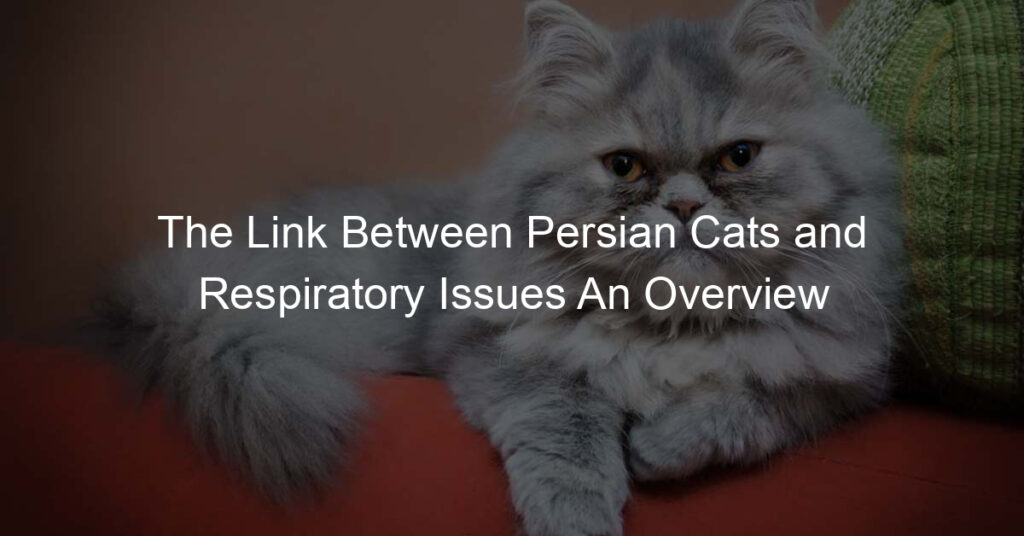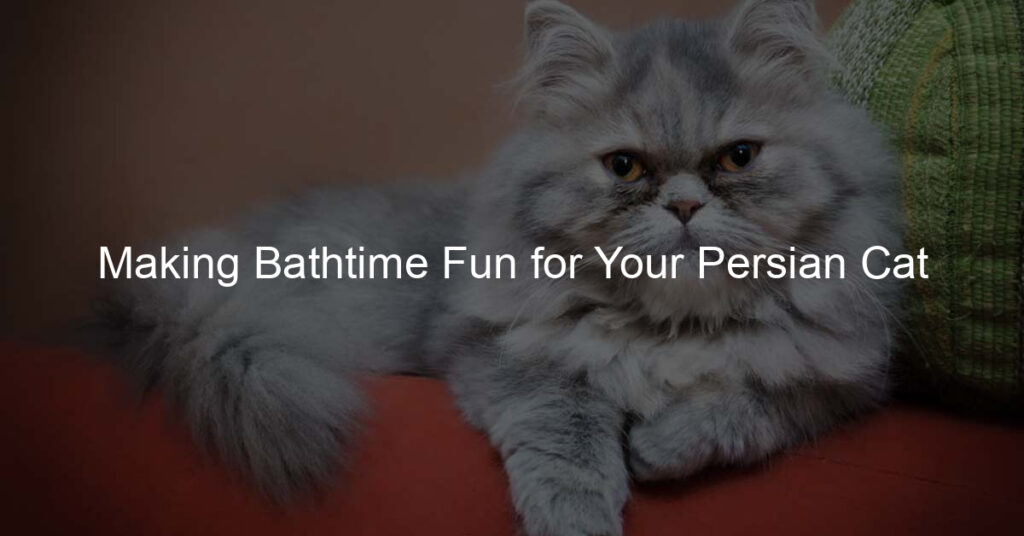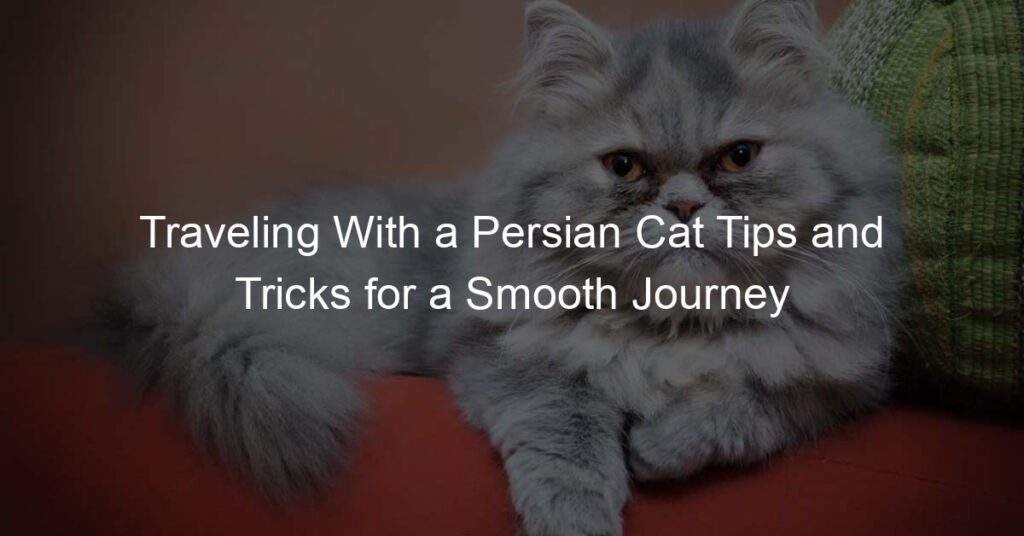Persian Cat Idioms from Around the World: What They Mean and Origin Stories
Idioms are expressions or phrases that have a figurative meaning different from the literal interpretation of the words. They add color and depth to our language, often rooted in cultural references, stories, and traditions. In this article, we explore a unique category of idioms – Persian Cat Idioms, which involve cats and their behaviors as metaphors for various situations. Discover these intriguing idioms and their meanings from different cultures across the globe.
Why Persian Cat Idioms?
Persian cats have long been associated with elegance, grace, and mystique. Their distinctive features and behaviors have inspired symbolism and idiomatic expressions in various languages. Exploring Persian Cat Idioms provides a fascinating window into cultural nuances, linguistic creativity, and the deep connection between humans and feline companions.
Common Persian Cat Idioms and Their Meanings
- The Cat’s Whiskers: Referring to someone or something that is exceptional or outstanding.
- Curiosity Killed the Cat: Warning against being too inquisitive or prying, as it may lead to trouble or harm.
- Let the Cat out of the Bag: Revealing a secret or confidential information unintentionally or prematurely.
- Look What the Cat Dragged In: Expressing surprise or disapproval at someone who arrives unexpectedly or brings unwelcome news.
- A Cat Nap: Taking a short, light sleep or resting for a brief period.
- Not Enough Room to Swing a Cat: Describing a very small space or cramped area.
- When the Cat’s Away, the Mice Will Play: Suggesting that without supervision or authority figures, people will indulge in mischief or misbehavior.
- Bell the Cat: Taking on a daring or dangerous task that others are reluctant to do.
- Fat Cat: Referring to a wealthy and influential person, often associated with corruption or unfair practices.
- Fighting Like Cats and Dogs: Describing strongly opposing or constantly arguing individuals or groups.
Origin Stories of Persian Cat Idioms
Each Persian Cat idiom has its own fascinating origin story that reflects cultural, historical, or mythological influences. Discover the fascinating tales behind these idioms and gain a deeper understanding of their cultural significance and symbolism.
Exploring Persian Cat Idioms not only provides insights into the rich tapestry of language and cultural expressions but also deepens our appreciation for the timeless influence and symbolism of cats in our lives. Join us on this journey as we unravel the enchanting world of Persian Cat Idioms.
Key takeaway:
- Persian Cat idioms add color and creativity to language: Persian Cat idioms provide a unique and imaginative way to express ideas metaphorically.
- Understanding idioms enhances cultural awareness: Delving into the meanings of Persian Cat idioms offers insights into Persian culture and its relationship with cats.
- Idioms can be traced back to historical and cultural contexts: Exploring the origin stories of Persian Cat idioms reveals the rich history and traditions behind these phrases.
What Are Idioms?
What Are Idioms?
Idioms are expressions or phrases that have a figurative meaning that is different from their literal meaning. They are commonly used in everyday language to add color and emphasis to our conversations. Idioms are an integral part of language, and understanding their meaning can help improve our overall comprehension and fluency.
Some common examples of idioms include “kick the bucket,” which means to die, “break a leg” which means good luck, and “barking up the wrong tree” which means to accuse or criticize the wrong person.
Idioms can be challenging for non-native speakers to understand because their meaning cannot be deduced from the individual words used. Instead, the meaning is derived from the cultural and historical context in which the idiom originated.
Learning idioms is crucial for effective communication, as they are frequently used in informal conversations and can add depth and humor to our language. They are a reflection of the culture and heritage of a particular language and provide insights into the unique characteristics of a community.
Idioms are expressions or phrases that have figurative meanings beyond their literal interpretations. Understanding idioms is essential for engaging in fluent and natural conversations, as they play a significant role in everyday language. So, next time you come across an unfamiliar idiom, don’t be afraid to ask for its meaning and context.
Why Persian Cat Idioms?
Persian cat idioms are an intriguing aspect of language and culture. There are several reasons to explore the significance of Persian cat idioms.
Firstly, Persian cat idioms have a rich cultural heritage deeply rooted in the history and culture of Persia. They provide a glimpse into the traditions, beliefs, and values of this ancient civilization.
Secondly, Persian cat idioms offer unique linguistic expressions. They utilize creative and colorful language to convey meaning, offering an interesting insight into the metaphorical and imaginative nature of the Persian language.
Thirdly, Persian cat idioms serve as cultural metaphors. Cats have long been associated with various qualities and characteristics in different cultures. In the case of Persian cat idioms, feline imagery is employed to express a wide range of emotions, traits, and situations, adding depth and nuance to the language.
Moreover, although Persian cat idioms originate from a specific culture, many of them contain universal themes that resonate with people from different backgrounds. They provide a unique perspective on human experiences and emotions.
Furthermore, exploring Persian cat idioms can foster cultural exchange and understanding. Learning about these idioms opens up opportunities to appreciate and connect with Persian culture and language.
Additionally, Persian cat idioms showcase the linguistic diversity of the Persian language and its ability to capture complex ideas and emotions. By studying these idioms, we gain a deeper appreciation for the intricate ways in which language can be used.
Common Persian Cat Idioms and Their Meanings
Discover the fascinating world of Persian cat idioms and their intriguing meanings. From “The Cat’s Whiskers” to “Fighting Like Cats and Dogs,” we’ll dive into the captivating origins and cultural significance of these phrases. Uncover the wisdom behind idioms like “Curiosity Killed the Cat” and “Let the Cat out of the Bag.” Prepare to be entertained and enlightened as we unravel the quirky language associated with our feline friends.
The Cat’s Whiskers
The phrase “The Cat’s Whiskers” is a popular idiom used to describe something or someone as being excellent or outstanding. It originated from the practice of the early 20th-century cat shows where the appearance and grooming of a cat, including its whiskers, were essential in determining its quality and breed standard.
The idiom “The Cat’s Whiskers” is often used to praise someone or something for its exceptional qualities. It implies that the person or thing being referred to is considered the best or most exceptional in its category. For example, if someone performs exceptionally well in a competition, they may be described as “the cat’s whiskers” to highlight their outstanding performance.
The use of this idiom is not limited to the feline world. It has become a part of everyday language and is often used figuratively to describe any person, object, or situation that is regarded as outstanding or of high quality.
It is important to note that idioms like “The Cat’s Whiskers” should not be taken literally. Instead, they are used to convey a figurative meaning or express an opinion. Understanding the context in which the idiom is used is crucial for accurate interpretation.
The idiom “The Cat’s Whiskers” is utilized to express admiration or high praise for something or someone. Its origin lies in the world of cats, where the grooming and appearance of a feline, including its whiskers, were important in determining its quality.
Curiosity killed the cat, but it also provided endless inspiration for Persian cat idioms.
Curiosity Killed the Cat
Curiosity Killed the Cat and the Importance of Caution
Curiosity killed the cat is a well-known phrase that cautions against being too inquisitive or nosy. The phrase implies that being too curious can be dangerous or lead to negative consequences. While the origin of this idiom is unclear, it is believed to have originated in medieval Europe. The phrase is often used to advise against unnecessary or unwarranted curiosity.
Curiosity killed the cat is a figurative expression and does not literally mean that curiosity will cause the death of a feline. Instead, it serves as a reminder to be cautious and to not pry into matters that are best left alone. It suggests that sometimes it is better to mind your own business and not dig too deep into things that may be harmful or cause trouble.
This idiom is widely understood and used in various contexts, both in everyday conversations and in literature. It reminds people to be mindful of the potential consequences of their actions and to exercise restraint when it comes to curiosity. So, while curiosity can be a valuable trait for acquiring knowledge and understanding, it is important to strike a balance and not let it get the better of us.
The phrase “curiosity killed the cat” serves as a reminder to proceed with caution and think twice before delving into matters that may be best left untouched.
Let the Cat out of the Bag
When it comes to the idiom “Let the Cat out of the Bag,” it refers to revealing a secret or sharing information that was supposed to be kept hidden. This idiom has its origins in medieval Europe and has been used widely in various cultures and languages.
- Origin: The exact origin of this idiom is uncertain, but it is believed to have originated in medieval Europe. In those times, farmers would often sell piglets in bags. Unscrupulous sellers would sometimes replace the piglet with a cat to deceive the buyer. If someone accidentally revealed the secret by letting the cat out of the bag, the deception would be exposed.
- Meaning: The idiom “Let the Cat out of the Bag” means to disclose a secret or reveal something that was meant to be kept hidden.
- Usage: This idiom can be used in various contexts, such as when someone unintentionally reveals confidential information or when a surprise or secret is spoiled.
- Example sentence: Sarah let the cat out of the bag by accidentally mentioning the surprise party to her best friend.
- Similar idioms: Other idioms with similar meanings include “spill the beans” and “blow one’s cover.”
Fun Fact: The idiom “Let the Cat out of the Bag” is just one of many cat-related phrases in different languages and cultures. Cats are often associated with secrecy, curiosity, or unpredictability, which has led to the creation of numerous idioms featuring them.
Looks like the cat dragged in a bag full of purr-sonal secrets and juicy gossip!
Look What the Cat Dragged In
- Look What the Cat Dragged In idiom is used to describe a person or thing that is dirty, messy, or undesirable.
- It implies that something or someone unexpected and unpleasant has arrived, much like when a cat brings in a dead animal or a random object from outside.
- This idiom is often used humorously to describe a person who appears disheveled or has a negative impact on a situation.
- For example, if someone shows up to a formal event wearing casual clothes and creating a scene, you might say, “Look what the cat dragged in!“
- It can also be used in a more literal sense, such as when a pet cat brings in a muddy shoe or a random item from the yard.
Fact: The origin of the phrase “Look What the Cat Dragged In” can be traced back to medieval Europe. In those times, cats were considered sneaky and mischievous creatures, often associated with witches and dark magic. The phrase was first used in relation to actual cats bringing in undesirable creatures or objects. Over time, it evolved into a metaphorical expression to describe unexpected and undesirable arrivals.
Need a quick break? Time for a cat nap!
A Cat Nap
A Cat Nap is a brief period of relaxation or slumber that a feline takes during the day. It is referred to as such because cats are recognized for their ability to sleep for extended periods and then swiftly awaken and become alert.
During A Cat Nap, a cat typically seeks out a cozy spot, curls up, and gently shuts its eyes. The duration of A Cat Nap can vary, but it typically lasts around 15-30 minutes. Cats take these naps throughout the day to replenish and renew their energy levels.
Engaging in A Cat Nap offers various advantages for both cats and humans. For cats, it helps them conserve energy and rejuvenate their bodies, ensuring they are prepared for playtime or hunting later on. As for humans, A Cat Nap can enhance productivity, improve focus and concentration, and contribute to overall well-being.
In order to make the most of A Cat Nap, it is crucial to establish a comfortable space devoid of distractions. Providing a cozy bed or blanket for your cat will encourage them to take their nap. Similarly, humans can enhance the quality of A Cat Nap by finding a tranquil and relaxing environment, such as a comfortable chair or a peaceful room.
A Cat Nap is a brief period of repose or slumber that cats indulge in during the day. It allows them to recharge and replenish their energy levels, and it can also bring benefits to humans. Therefore, the next time you observe your cat taking A Cat Nap, let them relish in their well-deserved rest.
Fact: Cats spend approximately 70% of their lives sleeping, which means they sleep for an average of 13 to 14 hours each day.
Persian cats have a reputation for being high-maintenance, but they definitely wouldn’t fit in a room with this idiom.
Not Enough Room to Swing a Cat
When it comes to the idiom “Not Enough Room to Swing a Cat,” there are a few key considerations to keep in mind:
- Literal meaning: The expression suggests that there is very little space to move or operate. It does not involve actual cats or swinging them.
- Common usage: This phrase is often used to describe cramped or crowded spaces where it is challenging to maneuver comfortably.
- Origin: The exact origin of this idiom is unclear, but it has been in use since the 17th century. It is believed to come from the nautical practice of using a cat o’ nine tails (a whip-like instrument) for punishment, which required enough space to swing it.
- Figurative usage: Nowadays, this idiom is used in everyday conversations to describe situations where there is an extreme lack of space or freedom of movement.
- Examples: You might hear this phrase used in contexts such as describing a tiny apartment, a crowded subway during rush hour, or a packed elevator.
- Alternatives: If you want to convey a similar idea, you can also use expressions like “cramped like sardines” or “packed like sardines,” both capturing the sense of limited space.
- Context: It’s important to consider the context in which you use this idiom. It should be used in informal or casual conversations rather than formal writing or professional settings.
- Understanding cultural references: Idioms can vary across different languages and cultures. To fully comprehend their meaning, it’s essential to explore the cultural context in which they are used.
When the Cat’s Away, the Mice Will Play
When the cat’s away, the mice will play is a popular idiom that means when someone in authority or a person who enforces rules is not present, others will take advantage of the situation and behave in a way they normally wouldn’t. This expression captures the idea that without supervision or consequences, individuals may indulge in mischief or activities they would otherwise avoid.
The origin of this idiom can be traced back to various cultural references and stories throughout history. Its earliest known appearance is in a play written by Robert Greene in the late 16th century. The phrase is also found in other forms in Greek, Latin, and French literature.
The idiom has become a common saying in English and is often used to describe situations where people feel tempted to break the rules or engage in activities that go against the norm when they know they won’t be caught or held accountable.
While it is important to understand the meaning and origin of idioms, it is equally crucial to use them appropriately and in the right context. Idioms like “the mice will play” add color and depth to our language and provide insights into different cultural perspectives.
Fact: Did you know that cats and mice have been depicted in literature and folklore for centuries? Their interactions often symbolize the dynamics between authority figures and those who seek freedom or mischief in the absence of supervision.
Bell the Cat: A purrfect guide to dealing with difficult jobs and unwarranted inquisitiveness.
Bell the Cat
When it comes to the Persian cat idiom “Bell the Cat,” it refers to the action of taking on a difficult or dangerous task for the benefit of others. Here are some key points to consider:
- The origin of this idiom can be traced back to medieval Europe, where it was believed that cats were cunning and unpredictable animals.
- The figurative meaning of “Bell the Cat” is to confront a challenging situation or take on a difficult job.
- This idiom is often used to describe someone who is willing to take risks and face the consequences in order to solve a problem or protect others.
- The phrase “Bell the Cat” implies that the task at hand is not easy and requires courage and determination.
- While the exact origins of this idiom are unclear, it has been used in various contexts throughout history.
Pro Tip: When faced with a daunting task, be willing to step up and “Bell the Cat.” Taking on challenges head-on can lead to personal growth and make a positive impact on others.
Big bellies and bigger wallets, these fat cats are living the purr-fect life.
Fat Cat
When it comes to the sub-topic “Fat Cat,” here are some important points to consider:
- A fat cat refers to an individual who is extremely wealthy or powerful.
- Fat cats often hold top positions in corporations or government organizations.
- These individuals are typically seen as having excessive wealth or influence.
- They are known to enjoy luxurious lifestyles with extravagant spending habits.
- Fat cats are often criticized for their disproportionate wealth and the unequal distribution of resources.
- They may be perceived as being out of touch with the average person’s reality and needs.
- The term “fat cat” is often used in a negative or critical context, highlighting income inequality and social injustice.
- The phrase can also be used metaphorically to describe someone who is arrogant or self-centered due to their wealth or power.
- Examples of fat cats can include wealthy CEOs, politicians, or celebrities with immense wealth and influence.
- It is important to be mindful of the implications of the term “fat cat” and the social issues it raises.
Fighting Like Cats and Dogs
- The idiom “Fighting Like Cats and Dogs” is a commonly used phrase to describe intense or constant arguments between two or more individuals.
- Its origin can be traced back to the observation that cats and dogs are often seen as natural enemies due to their different behaviors and characteristics.
- This phrase implies that the individuals involved in the argument have a highly hostile and contentious relationship resembling that of cats and dogs.
- It suggests that the arguments or conflicts between them are frequent, intense, and challenging to resolve.
- This idiom can be applied to various scenarios, such as siblings who constantly fight or colleagues who frequently clash in the workplace due to opposing views.
- It highlights the idea that the individuals involved fundamentally disagree, making it difficult for them to get along.
- The phrase “Fighting Like Cats and Dogs” does not necessarily imply physical violence but rather a continuous and intense verbal or emotional battle.
- Addressing conflicts and disagreements productively is essential for creating a more harmonious and collaborative environment.
- By understanding and respecting each other’s perspectives, the intensity of disagreements can be mitigated, leading to better communication and cooperation.
- Instead of “Fighting Like Cats and Dogs,” striving for collaboration and compromise is crucial to find common ground and effectively resolve conflicts.
Origin Stories of Persian Cat Idioms
Discover the fascinating world of Persian cat idioms as we delve into the origin stories that gave birth to these expressions. From “The Cat’s Whiskers” to “Fighting Like Cats and Dogs,” each sub-section unveils the rich history and cultural significance behind these curious phrases. Get ready to uncover the hidden tales and intriguing origins that have shaped the way we understand and use these idioms in everyday conversations. Prepare to be whisked away into a world of feline-inspired linguistic wonders!
The Cat’s Whiskers
The Cat’s Whiskers is a popular idiom that originated from Persian Cat idioms. Here are some key facts and meanings associated with this idiom:
- Meaning: The phrase “the cat’s whiskers” is used to describe something or someone that is considered excellent or outstanding.
- Origin: The origin of this idiom can be traced back to the early 20th century when cats were highly regarded for their hunting abilities and their prominent whiskers. The whiskers allowed cats to navigate and detect obstacles in the dark, making them highly skilled and valuable animals.
- Usage: The idiom is typically used to express admiration or praise for someone or something. It signifies that the person or thing being referred to is remarkable and stands out from the rest.
- Examples: “Her new book is the cat’s whiskers, receiving rave reviews from critics.” “The latest smartphone model is truly the cat’s whiskers with its cutting-edge features and sleek design.”
It is interesting to note how idioms like “the cat’s whiskers” have transcended cultural boundaries and continue to be used in various languages and cultures around the world, highlighting the universal fascination with feline grace and prowess.
Curiosity Killed the Cat
Curiosity Killed the Cat is a common idiom that is used to caution against being too curious or inquisitive, as it can lead to trouble or harm. This phrase is often used to remind people that being excessively curious can have negative consequences.
Curiosity Killed the Cat is a common idiom that is used to caution against being too curious or inquisitive, as it can lead to trouble or harm. This phrase is often used to remind people that being excessively curious can have negative consequences.
The origin of this idiom is unclear, with various theories proposed. One theory suggests that the phrase originated from an old proverb in medieval Europe that warned against the dangers of curiosity. Another theory suggests that the phrase may have its roots in Jewish sources, where curiosity is associated with disobedience and forbidden knowledge.
Regardless of its origin, the meaning of Curiosity Killed the Cat remains consistent. It serves as a reminder to exercise caution and not to overstep boundaries or pry into matters that do not concern us.
In our daily lives, this idiom can be applied in many situations. For example, it is important not to pry into someone’s personal affairs or invade their privacy. It is also applicable when resisting the urge to dig too deeply into sensitive or confidential information.
While curiosity is generally seen as a positive trait that drives learning and exploration, it is essential to strike a balance and not let it lead to reckless behavior or meddling in the affairs of others. By keeping our curiosity in check, we can avoid unnecessary problems and maintain healthier relationships with those around us.
So remember, while it is natural to be curious, it is important to understand that excessive curiosity could potentially lead to negative outcomes. It’s all about finding the right balance and knowing when to respect boundaries.
Let’s unleash the feline secrets and reveal the true meaning of Let the Cat out of the Bag.
Let the Cat out of the Bag
is a common idiom that means to reveal a secret or disclose information that was meant to be kept hidden or confidential.
The origin of this idiom is unclear, but there are several theories. One theory suggests that it originated from medieval Europe, where merchants would sell piglets in bags. Sometimes they would substitute a cat instead, hoping that the buyer wouldn’t notice. If the buyer discovered the deception, they would “let the cat out of the bag” by opening the bag and revealing the truth.
Another theory traces the idiom back to ancient Egypt, where it is believed to have originated from the myth of the Egyptian sun god Ra. According to the myth, Ra transformed himself into a cat and hid in a bag, intending to spy on humans. When he was discovered, he was “let out of the bag” and his true identity was revealed.
Regardless of its origin, the idiom is now widely used in the English language. It is often used when someone unintentionally reveals a secret or when a hidden truth is exposed. For example, if someone accidentally reveals a surprise party to the guest of honor, you could say that they “let the cat out of the bag.”
Look What the Cat Dragged In
When it comes to the idiom “Look What the Cat Dragged In,” here are some key points to consider:
- The idiom “Look What the Cat Dragged In” is used to express surprise or disappointment upon seeing someone or something that is unpleasant, unexpected, or of poor quality.
- It is often used in informal situations to comment on the appearance or behavior of someone who is disheveled, unclean, or otherwise unappealing.
- The phrase originates from the idea that a cat may bring back dead animals or other unappealing items as a “gift” to its owner.
- While the exact origin of the phrase is unknown, it is believed to have been used since at least the 17th century.
- The phrase has become a popular saying in English and is used in various contexts, ranging from humorous to derogatory.
- It is important to note that the use of this phrase should be done with caution, as it can be seen as ruin or offensive depending on the context and the tone of the conversation.
- As with any idiom, it is essential to understand its figurative meaning and use it appropriately to avoid misunderstandings.
- Overall, “Look What the Cat Dragged In” is a colorful expression that adds a touch of humor or disdain, depending on the situation.
A Cat Nap
A cat nap is a short period of sleep taken during the day by a cat. Cats are known to sleep for long hours throughout the day, with intermittent naps to rejuvenate themselves. These short naps provide them with the energy they need to be active and alert.
Taking a cat nap can also be beneficial for humans. It can help improve productivity, enhance cognitive function, and boost overall well-being. Research has shown that a short power nap of around 20 minutes can improve focus, memory, and creativity.
During a cat nap, the brain enters a state of light sleep, allowing it to rest and recharge. It helps in reducing fatigue and increasing alertness, making it easier to concentrate on tasks.
To make the most of a cat nap, find a quiet and comfortable environment where you can relax. Set an alarm to ensure you don’t oversleep and feel groggy afterward. Keep the nap short to avoid disrupting your nighttime sleep schedule.
Incorporating a cat nap into your daily routine can be a healthy habit, especially if you have a busy schedule or feel tired during the day. It can provide a quick energy boost and help you maintain optimal performance throughout the day.
Remember, a cat nap is not a substitute for a good night’s sleep. It is merely a way to recharge and refresh yourself during the day. Listen to your body’s signals and take a short nap when needed to enhance your overall productivity and well-being.
Not Enough Room to Swing a Cat
Not Enough Room to Swing a Cat is a figurative phrase that signifies the scarcity of space in a particular area or situation. Its origin dates back to medieval Europe, where rooms were often small and cramped.
The phrase alludes to the idea that a room would be considered very small if there wasn’t even enough space to physically swing a cat. However, it is important to understand that this expression should not be taken literally, as it is solely used to convey a lack of space.
This idiomatic expression can be applied to various scenarios. For instance, if someone resides in a minuscule apartment, they can state that there is not enough room to swing a cat. Similarly, in a small meeting room, individuals may comment on the limited space available by mentioning that there is not enough room to swing a cat.
In summary, the phrase “not enough room to swing a cat” is a metaphorical expression that depicts a situation where there is very little space accessible. It should not be interpreted literally but rather understood as a symbol for a cramped or confined area.
When the cat’s away, prepare for partying mice and mayhem!
When the Cat’s Away, the Mice Will Play
“When the cat’s away, the mice will play” is a well-known idiom that implies that when someone in authority is not present, people will take advantage of the situation and behave in a less disciplined or responsible manner.
This idiom can be applied to various contexts, such as the workplace, schools, or even within a household. In a workplace setting, when a supervisor or manager is absent, employees may be less focused on their tasks and engage in activities unrelated to work. Similarly, in a school environment, when the teacher is not present, students may become more rowdy or engage in behavior that they wouldn’t if the teacher were there.
The origins of this idiom date back to ancient times, with similar sayings found in different cultures. The concept of mischief or misbehavior occurring when authority figures are absent or not paying attention is universal. It speaks to the human tendency to relax our behavior and let loose when we perceive a lack of supervision.
“When the cat’s away, the mice will play” is a phrase that highlights the natural inclination for individuals to take advantage of freedom or absence of authority. It serves as a reminder to stay vigilant and disciplined even when there isn’t direct supervision.
Bell the Cat
When it comes to the Persian Cat idiom “Bell the Cat,” here are some key points to consider:
- “Bell the Cat” is a phrase that means taking a bold action or assuming a difficult task that others may be unwilling to do.
- The origin of this idiom can be traced back to medieval Europe where cats were believed to possess mystical powers. According to the legend, a group of mice wanted to put a bell around the cat’s neck to warn them of its presence. None of the mice were willing to take on the dangerous task of actually putting the bell on the cat.
- The phrase “Bell the Cat” is often used to describe situations where someone suggests a brave or necessary action but no one is willing to take the responsibility to carry it out.
- Belling the cat requires courage, initiative, and the willingness to take risks. It is about stepping up and doing what needs to be done, even if it is challenging or uncomfortable.
- In today’s context, “Bell the Cat” can be applied to various scenarios, such as being the first to raise concerns in a group, volunteering for a difficult task, or speaking up against injustice.
Remember, the idiom “Bell the Cat” reminds us of the importance of taking action and not just suggesting or discussing solutions. It encourages individuals to be proactive and courageous in tackling challenges, even when others may hesitate.
Fact: The phrase “Bell the Cat” is not exclusive to Persian Cat idioms and has variations in other languages, symbolizing the same concept of taking on a difficult task or assuming personal risk.
Fat Cat
A Fat Cat refers to a wealthy and influential person who enjoys a luxurious lifestyle. This idiom is frequently used to describe individuals who are excessively rich or powerful and often have a sense of entitlement. The term “fat cat” conveys the idea that these individuals have amassed a considerable amount of wealth or power and are living a life of extravagance.
The origin of the idiom “fat cat” can be traced back to the early 20th century. It is believed to have originated in the United States during the Roaring Twenties, a period known for its economic prosperity and growing social inequality. The term was used to describe wealthy businessmen and politicians who were perceived to be living lavish lifestyles while the majority of the population struggled financially.
The figurative meaning of “fat cat” suggests a person who is living beyond their means and is flaunting their wealth and power. It is often used in a critical or disapproving manner to highlight the divide between the rich and the poor.
In modern usage, the term “fat cat” is still commonly used to criticize or comment on individuals who are seen as benefiting unfairly from the economic system. It is often used in political discourse to criticize corporate executives or politicians who are perceived to be enriching themselves at the expense of the general public.
The idiom “fat cat” is a powerful metaphor that captures the idea of wealth and excess. It serves as a reminder of the inequalities in society and highlights the influence that money and power can have on an individual’s lifestyle and behavior.
Fighting Like Cats and Dogs
When it comes to the popular saying “fighting like cats and dogs,” it refers to two people or animals who are constantly arguing or disagreeing with each other. This phrase is often used to describe situations where there is a lot of conflict and tension.
| Frequent arguments: People or animals who are fighting like cats and dogs often engage in frequent arguments or disagreements. These arguments can be intense and may involve yelling, bickering, or even physical fights. Opposing personalities: The phrase “fighting like cats and dogs” implies that the individuals involved have opposing personalities or temperaments. They may have different opinions, values, or ways of doing things, which can lead to clashes and conflicts. Tension and animosity: The phrase also suggests a sense of tension and animosity between the parties involved. It implies that the relationship is strained, and there is little or no mutual understanding or respect. Incompatibility: People or animals who are constantly fighting like cats and dogs may simply be incompatible. Their differences may be too great to overcome, resulting in ongoing conflict.No resolution: The phrase also suggests that there is no resolution in sight. The conflicts between the parties involved continue, and there is little hope for reconciliation or harmony. |
I once had two neighbors who were constantly fighting like cats and dogs. They would argue loudly over small matters, such as parking spaces or noise levels. Their animosity towards each other was evident, and it created a tense and uncomfortable atmosphere in our neighborhood. Despite attempts to mediate and resolve their issues, their conflicts persisted. It was a reminder that not all relationships can be salvaged and that some individuals are simply not compatible with each other.
Persian Cat Idioms from Around the World: What They Mean and Origin Stories
- ✅ One hand doesn’t clap: Teamwork or cooperation is necessary for success. (Source: Arabic)
- ✅ Stop ironing my head: Stop annoying me! (Source: Armenian)
- ✅ Seeing the reflection of a bow in a cup and thinking it’s a snake: Worrying about things that don’t exist. (Source: Chinese Mandarin)
- ✅ To walk around hot porridge: To beat around the bush. (Source: Czech, Norwegian)
- ✅ To have a pin in your ear: Not listening to someone. (Source: Danish)
Frequently Asked Questions
What is the origin of the phrase “the cat’s meow”?
The phrase “the cat’s meow” originated in the 1920s and was used by fashionable and modern individuals to express high praise.
Where does the phrase “cat got your tongue?” come from?
The phrase “cat got your tongue?” has no definitive origin, but it may have originated from punishments in ancient societies, witchcraft beliefs, or the fear of being whipped in the English navy.
When did the phrase “let the cat out of the bag” originate?
The phrase “let the cat out of the bag” dates back to at least the mid-eighteenth century and may have originated from a scam by marketplace vendors who would substitute a cat for a pig.
Who first mentioned the phrase “raining like cats and dogs” in writing?
The phrase “raining like cats and dogs” was first mentioned in writing in 1651 by British poet Henry Vaughan, but its exact origin is unknown.
What role do idioms play in language and communication?
Idioms play an important role in language and communication as they amplify messages and awaken the senses.
Why is it helpful to know idioms in other languages?
Knowing idioms in other languages helps to “think” in that language and understand the customs and values of a foreign culture.
